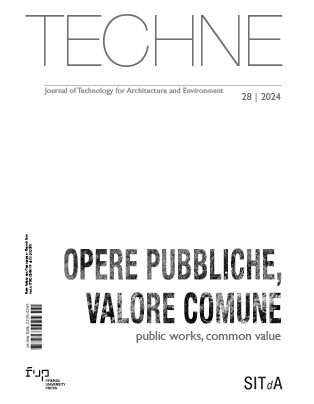The Green Connections: Adaptive, Integrated, and Nature-Based Solutions for Urban Historic Centres
Published 2024-10-29
Keywords
- Ecological transition,
- Nature-based interventions,
- Microclimatic well-being,
- Participation,
- Urban regeneration
How to Cite
Copyright (c) 2024 Danila Longo, Rossella Roversi, Martina Massari, Kristian Fabbri, Riccardo Mercuri

This work is licensed under a Creative Commons Attribution 4.0 International License.
Abstract
Choosing adaptation and mitigation actions, through nature-based solutions, fosters the ecological transition process, which is necessary to face the challenges of climate change. However, these interventions are often discontinuous and disconnected, especially within dense and delicate urban fabrics such as historic centres. The research proposes a multi-scalar methodological approach aimed at defining an integrated design tool to improve the microclimatic well-being, accessibility and aesthetic quality of open spaces located in consolidated urban environments. Through the synergy between natural, technological and social components, the aim is to create replicable minimum intervention units designed to foster democratic and ecosystemic connections.
Downloads
References
- Andersson, E., Barthel, S., Borgström, S., Colding, J., Elmqvist, T., Folke, C., & Gren, Å. (2014). “Reconnecting cities to the biosphere: stewardship of green infrastructure and urban ecosystem services.” Ambio, Vol. 43, pp. 445-453. Available at: https://doi.org/10.1007/s13280-014-0506-y. DOI: https://doi.org/10.1007/s13280-014-0506-y
- Cascone, S. (2023). Le infrastrutture verdi per la mitigazione e l’adattamento ai cambiamenti climatici. EDIFIR, Firenze.
- Eggermont, H., Balian, E., Azevedo, J. M. N., Beumer, V., Brodin, T., Claudet, J., … & Le Roux, X. (2015).
- “Nature-based solutions: new influence for environmental management and research in Europe.” GAIA Ecological perspectives for science and society, Vol. 24, n.4, pp. 243-248. Available at: https://doi.org/10.14512/gaia.24.4.9. DOI: https://doi.org/10.14512/gaia.24.4.9
- European Commission (2024), Green infrastructure. Available at: https://environment.ec.europa.eu/topics/nature-and-biodiversity/green-infrastructure_en (Accessed on 26-01-2024).
- Haase, D. (2021). “Integrating Ecosystem Services, Green Infrastructure and Nature-Based Solutions-New Perspectives in Sustainable Urban Land Management: Combining Knowledge About Urban Nature for Action.” in Sustainable Land Management in a European Context: A Co-design Approach, pp. 305-318. Available at: https://doi.org/10.1007/978-3-030-50841-8_16. DOI: https://doi.org/10.1007/978-3-030-50841-8_16
- Manzini, E. (2021), Abitare la prossimità. Idee per la città dei 15 minuti, Egea, Milano.
- Nieuwenhuijsen, M. J. (2021). “Green infrastructure and health.” Annual Review of Public Health, Vol. 42, pp. 317-328. Available at: https://doi.org/10.1146/annurev-publhealth-090419-102511. DOI: https://doi.org/10.1146/annurev-publhealth-090419-102511
- Orioli, V. (2023). “Dal Piano al progetto dello spazio pubblico: l’Impronta Verde e la Città 30.” Eco Web Town, Vol.27, n. 2039, p. 21.
- Sabbion, P., and Tucci, G. (2017). “City Greening, strategie per il paesaggio urbano tra estetica e salubrità.” Ri-Vista. Research for landscape architecture, Vol. 15, n.1, pp. 32-45.
- Scott, M.; Lennon, M.; Haase, D.; Kazmierczak, A.; Clabby, G.; Beatley, T. (2016) “Nature-Based Solutions for the Contemporary City/Re-Naturing the City/Reflections on Urban Landscapes, Ecosystems Services and Nature-Based Solutions in Cities/Multifunctional Green Infrastructure and Climate Change Adaptation: Brownfield Greening as an Adaptation Strategy for Vulnerable Communities?/Delivering Green Infrastructure through Planning: Insights from Practice in Fingal, Ireland/Planning for Biophilic Cities: From Theory to Practice.” Planning Theory & Practice, Vol. 17, pp. 267-300. Available at: https://doi.org/10.1080/14649357.2016.1158907. DOI: https://doi.org/10.1080/14649357.2016.1158907
- United Nations Environment Assembly of the United Nations Environment Programme UNEP/EA.5/Res.5 (2022), Information on reports and updates by the Technology and Economic Assessment Panel. Available at: https://www.unep.org/ (Accessed on 26-01-2024).
- Wilhelm, K., Pam, B., Nicolas, B., Cecchi, C., Thomas, E., Marta, F. et al., (2015). Towards an EU research and innovation policy agenda for nature-based solutions & re-naturing cities. Final report of the Horizon 2020 expert group on nature-based solutions and re-naturing cities. Available at: https://op.europa.eu/en/publication-detail/-/publication/fb117980-d5aa-46df-8edc-af367cddc202 (Accessed on 26-01-2024).






